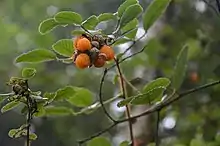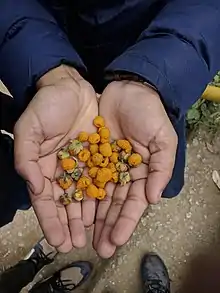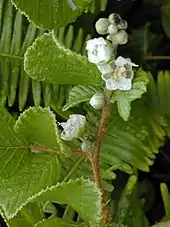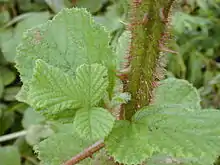| Rubus ellipticus | |
|---|---|
 | |
| Himalayan raspberry (Ainselu) fruit at Shivapuri National Park, Nepal | |
| Scientific classification | |
| Kingdom: | Plantae |
| Clade: | Tracheophytes |
| Clade: | Angiosperms |
| Clade: | Eudicots |
| Clade: | Rosids |
| Order: | Rosales |
| Family: | Rosaceae |
| Genus: | Rubus |
| Subgenus: | R. subg. Idaeobatus |
| Species: | R. ellipticus |
| Binomial name | |
| Rubus ellipticus Sm. 1815 | |
| Synonyms[1][2] | |
| |
_from_Kathmandu%252C_Nepal.jpg.webp)
Rubus ellipticus, commonly known as ainselu,[3] golden evergreen raspberry,[4] golden Himalayan raspberry, or yellow Himalayan raspberry,[5] is an Asian species of thorny fruiting shrub in the rose family. It's native range stretches from the Indian subcontinent (Nepal, India, Sri Lanka and Pakistan) to southern China and Indochina and the Philippines.[6]
Description
_from_Nepal.jpg.webp)
The golden Himalayan raspberry is a large shrub with stout stems that can grow to up to 4.5 metres (15 ft) long. Its leaves are trifoliate, elliptic, or obovate and toothed with long bristles. Its leaves can grow to up to 5 to 10 cm (2 to 4 in) long. Its flowers are short, white, and have five petals and grow in clusters, and blooms in the Himalayas between the months of February and April.[6] Its fruit are sweet, detachable, and highly sought after by birds and elephants.[7][8][9][10]
Rubus ellipticus is sweet to the taste, though it is not commonly harvested for domestic use.[11] The fruit perishes quickly after plucking from the thorny bush.
Taxonomy
It was first published and described by James Edward Smith in (A.Rees editted), Cycl. 30: n.° 16 in 1815.[6][12]
Etymology
The fruit has various names in South-Asian languages. It is called ainselu (Nepali: ऐँसेलु) in Nepali, hisalu (Kumaoni: हिसालु) in Kumaoni, hisol (Garhwali: हिसोल) in Garhwali, nyinch (Nyishi: निंच) in Nyishi, and sohshiah (Khasi: सोहशियाह) in Khasi language.
Distribution and habitat
The golden Himalayan raspberry's origin is in the temperate Himalayas region, and is native to India, Pakistan, Nepal, southern China, Assam, Laos, Myanmar, the Philippines, Sri Lanka, Thailand, Tibet and Vietnam.[12]
It is found as a weed in open grasslands and rarely in forests of Himalayan states of India e.g. Himachal and Uttarakhand in their higher reaches at an attitude of 1,500 to 2,100 m (4,900 to 6,900 ft).[13] It is often found in pine forests of the region.[14]
The golden Himalayan raspberry can be found in mesic or wet forests, and have adapted to be able to live in complete shade and in full sun exposure.[9]
Ecology
As with other Rubus species, its seeds are readily distributed by birds.[15] It can also propagate, or asexually reproduce, itself through cutting.[16] It can grow in open fields or in canopies of moist forests.
The Himalayan raspberry can also support large populations of Drosophila, or fruit flies, from its rotting fruit,[8] and its fruits are also consumed by elephants.[17]

Invasiveness


Rubus ellipticus is listed in the IUCN Invasive Species Specialist Group database as an Invasive species, one of the world's 100 worst invasive species.[8] It has been introduced into; Ecuador, Jamaica, Java, Malawi, Mozambique, New South Wales, Queensland (both in Australia) and Tanzania.[12] It was first introduced in 1961 in Hawaii as an edible fruit and as an ornamental plant.[9]
The yellow Himalayan raspberry poses a threat to native communities because it forms thick, impenetrable thickets, and competes with the native Hawaiian raspberry.[8][11] Abandoned farms and lands disturbed by feral pig populations are also susceptible to invasion. Its ability to grow tall due to its stout stems is also a threat because of its ability to establish itself within the tree canopy.[10] The yellow Himalayan raspberry is also a threat to native flora because it can outcompete other plants. More specifically, it has higher photosynthetic rates, has higher nitrogen fixation rates, and therefore a higher photosynthetic nitrogen use efficiency (or PNUE).[16]
The yellow Himalayan raspberry is currently only invasive on Hawaii.[10] It is considered a noxious weed by the National Park Service and the Hawaiian Department of Agriculture.[15]
Control strategies
Due to its limited range, the golden Himalayan raspberry has been contained to a few stations on Hawaii. Any new populations are to be eliminated as quickly as possible.[15] Control practices at Hawaii Volcanoes National Park has shown that simply identifying and removing the shrub can help dramatically reduce its invasive impact.[18]
To fully eliminate a yellow Himalayan raspberry shrub, its roots systems must be pulled out. The shrub shoots out roots deep underground after a fire or cutting. Fire can be applied to the roots if the shrub has been removed by physical means. Herbicide, such as Roundup, a common pesticide, can also be used in containing the shrub.[9]
Uses
Nepal farmers have had limited success in harvesting and fermenting the aiselu fruit to produce a fruit wine.[19] In Sikkim, its roots are used to treat stomach pain and headaches, and its fruits are used to treat indigestion.[20]
The bark from this plant is used for medical reasons in Tibetan villages, mainly as a renal tonic and an antidiuretic.[11] Its juices can also be used to treat coughs, fevers, colic and sore throat.[21] The plant can also be used to make a bluish-purple dye.[11]
The fruits of golden Himalayan raspberry was recorded as rich source of phenolics, Beta carotenes, ascorbic acid (vitamin C), many other important metabolites and antioxidants.[22] The leaves also contain various helpful properties as well.[23] The fruit extracts of R. ellipticus contain antimicrobial properties (Ding et al. 2008).[24]
See also
- Choerospondias axillaris, also known as lapsi
- Myrica esculenta, also known as kafal
References
- ↑ "The Plant List, Rubus ellipticus Sm".
- ↑ {{Tropical Plants Database, Ken Fern. tropical.theferns.info. 2021-09-11. <tropical.theferns.info/viewtropical.php?id=Rubus+ellipticus>}}
- ↑ "Aiselu Wine: A Community Project in Nepal". Aiselu Wine: A Community Project in Nepal. Retrieved 2020-06-11.
- ↑ "Rubus ellipticus". Useful Tropical Plants. Retrieved 2020-06-11.
- ↑ USDA, NRCS (n.d.). "Rubus ellipticus". The PLANTS Database (plants.usda.gov). Greensboro, North Carolina: National Plant Data Team. Retrieved 25 October 2015.
- 1 2 3 "Rubus ellipticus Smith, 1815. 椭圆悬钩子 tuo yuan xuan gou zi". Flora of China.
- ↑ Chen, Jin; et al. (2006). "Diet composition and foraging ecology of Asian elephants in Shangyong, Xishuangbanna, China". Acta Ecologica Sinica. 26 (2): 309–316. doi:10.1016/S1872-2032(06)60006-1.
- 1 2 3 4 "Rubus ellipticus". Invasive Species Specialist Group. 20 July 2006. Retrieved 17 July 2010.
- 1 2 3 4 "Yellow Himalayan Raspberry". PCA Plant Conservation Alliance's Alien Plant Working Group. nps.org. 7 July 2009. Retrieved 22 November 2016.
- 1 2 3 Stratton, Lisa (December 1996). The Impact and Spread of Rubus ellipticus in 'Ola'a Forest Tract Hawai'i Volcanoes National Park. Madison, Wisconsin: University of Wisconsin-Madison.
- 1 2 3 4 "Rubus ellipticus". Global Invasive Species Database. Invasive Species Specialist Group. 20 July 2006. Retrieved 22 November 2016.
- 1 2 3 "Rubus ellipticus Sm. | Plants of the World Online | Kew Science". Plants of the World Online. Retrieved 30 October 2023.
- ↑ Singh, Anurudh K (March 2017). "Revisiting the Status of Cultivated Plant Species Agrobiodiversity in India: An Overview". Proc Indian Natl Sci Acad. 83 (1): 151–174. doi:10.16943/ptinsa/2016/v82/48406.
- ↑ Negi, P.S. (2008). "Bio-diversity: A Vanishing Himalayan Splendour". Uttarakhand, Need for a Comprehensive Eco-strategy: 317–338.
- 1 2 3 Jacobi, James D.; Warshauer, Frederick R. (1992). Stone, Charles P.; Smith, Clifford W.; Tunison, J. Timothy (eds.). Distribution of six alien plant species in upland habitats on the island of Hawaii. University of Hawaii, Honolulu: Cooperative National Park Resources Studies Unit. pp. 155–188.
- 1 2 Funk, Jennifer L. (10 September 2008). "Differences in plasticity between invasive and native plants from a low resource environment". Journal of Ecology. 96 (6): 1162–1173. Bibcode:2008JEcol..96.1162F. doi:10.1111/j.1365-2745.2008.01435.x. S2CID 84336174.
- ↑ Jin, Chen; Xiaobao, Deng; Ling, Zhang; Zhilin, Bai (February 2006). "Diet composition and foraging ecology of Asian elephants in Shangyong, Xishuangbanna, China". Acta Ecologica Sinica. 26 (2): 309–316. doi:10.1016/S1872-2032(06)60006-1.
- ↑ Tunison, J. Timothy; Stone, Charles P. (1992). Special ecological areas: an approach to alien plant control in Hawaii Volcanoes National Park. Alien plant invasions in native ecosystems of Hawai'i: management and research. pp. 781–798.
- ↑ Dahal, S. "Making of Nepali Wine". Nepali Times. Retrieved 25 November 2015.
- ↑ Pradhan, Bharat K; Badola, Hemant K (1 October 2008). "Ethnomedicinal plant use by Lepcha tribe of Dzongu valley, bordering Kanchendzonga Biosphere Reserve, in North Sikkim, India". Journal of Ethnobiology and Ethnomedicine. 4: 22. doi:10.1186/1746-4269-4-22. PMC 2567294. PMID 18826658.
- ↑ "Rubus ellipticus". Useful Tropical Plants. Retrieved 22 November 2016.
- ↑ Badhani, Amit; Rawat, Sandeep; Bhatt, Indra D.; Rawal, Ranbeer S. (29 July 2015). "Variation in chemical constituents and antioxidant activity in Yellow Himalayan (Rubus ellipticus Smith) and hill raspberry (Rubus niveus Thunb.)". Journal of Food Biochemistry. 39: 667–672. doi:10.1111/jfbc.12172.
- ↑ George, B.P.; Parimelazhagan, T.; Saravanan, S. (2013). "Anti-inflammatory, analgesic and antipyretic activities of Rubus ellipticus smith. leaf methanol extract". International Journal of Pharmacy and Pharmaceutical Sciences. 5 (2): 220–224.
- ↑ Ding, J.; Wu, K.; Zhang, J. (2008). "Preliminary exploration for natural enemies of Rubus ellipticus in China". Retrieved 22 September 2021.
External links
 Media related to Rubus ellipticus at Wikimedia Commons
Media related to Rubus ellipticus at Wikimedia Commons- "Rubus ellipticus". Plants for a Future.